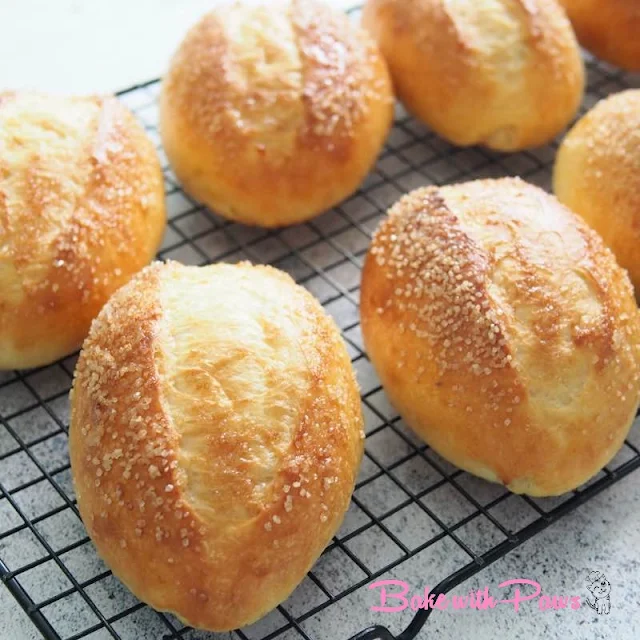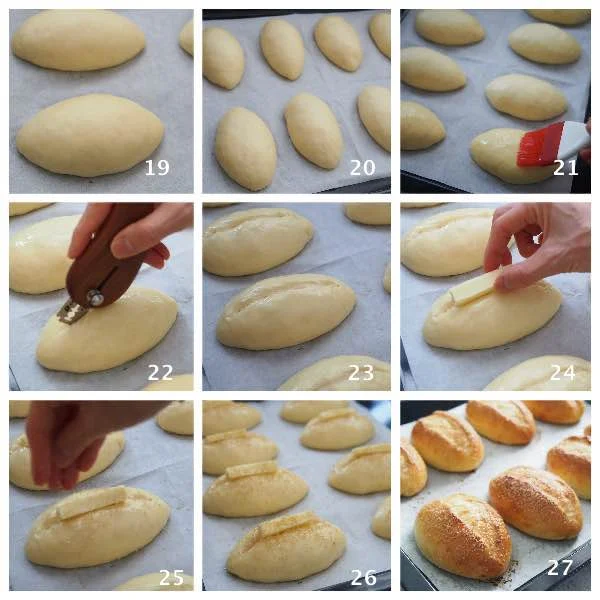Breads (Sourdough) - Soft Buns/Rolls
Butter Sugar Buns (Sourdough)
November 20, 2020
| Recipe by Bake with Paws
Scroll to the bottom of the page for "PRINT RECIPE" ⬇
This is an improved recipe for Sourdough Butter Sugar Buns to replace the previous version (using Sweet Liquid Levain) that I have already deleted from this post.
I used my favourite Sweet Stiff Starter recipe that I have been using in almost all of my Soft Sourdough Breads. In this recipe, a high percentage of sweet tiff starter is used to help cut down proofing times and make the bread rise faster. These buns took only 1 hour and 45 minutes at final proofing.
I believe using a Sweet Stiff Starter achieves a good consistent result. I have also tried this with a non-Yudane method and making it with Yudane is the clear winner. The buns stay fresh and moist longer compared with the bread that not using yudane method.
Yudane method is quite similar to Tangzhong (water-roux) method. Both methods are scalding methods. For the Yudane method, boiling water is used to scald the flour instead of cooking over the fire. Please click here to see more details about Yudane and Thangzhong Method.
These Sourdough Butter Sugar Buns are very soft and fluffy. It does not taste sour to me but to be honest, most of the sourdough bread will have a touch of sourness. Sometimes it may be quite strong and and sometimes I won't really taste it. Normally the sourness is least pronounced with high enriched bread recipes eg. brioche.
If you are looking for an instant dried yeast version, please click Butter Sugar Buns that I shared a few years ago which also happens to be one of the most popular posts in my blog.
How to store Sourdough Butter Sugar Buns:
This Sourdough Butter Sugar Buns can be stored in plastic wrap or container with cover for 1 - 2 days at room temperature (28C - 30C) or up to three days at room temperature (22C - 25C) After these period you need to keep in fridge for few days. Reheat in a 200C oven for 5 minutes before eating.
If you have any questions regarding this recipe or any other post, please leave me a comment in the “LEAVE A COMMENT” link and I will reply you as soon as possible. Do tag me on Instagram @Bakewithpaws if you attempt on this recipe.
How To Make Butter Sugar Buns (Sourdough)
Yields: 8 buns
INGREDIENTS:
Yudane Dough:
70g bread flour (I used Japan High Gluten Flour)
70g boiling water
Sweet Stiff Starter:
60g sourdough starter (100% Hydration), use at its peak
180g bread flour (I used Japan High Gluten Flour)
75g water or 90g milk
30g sugar (I used organic brown sugar)
Main Dough:
70g bread flour (I used Japan High Gluten Flour)
All yudane dough (above)
All stiff starter (above)
10g brown sugar (I used organic brown sugar)
1 tsp (5.5g) salt
45g egg, whisked (from 1 egg), balance use for egg wash
25g milk or whipping cream (reserve 10g and add in later if needed) I used total 25g of whipping cream
25g butter, room temperature
Topping:
Egg Wash: Balance from the above egg + 1 tsp water
Butter: 35g butter, cold and cut into long stick
Some coarse sugar
Sea salt flakes
Utensil:
1 baking tray, lined with parchment paper.
* Sometimes I used young sourdough discard and it works too. It is very much depend on your starter.
METHOD:
- Yudane (Please watch this video ):
- Add bread flour in a bowl, pour the boiling water and mix well with spatula or spoon until no dry flour.
- Cover and rest for at least 4 hours or overnight in the fridge. I prepared the night before.
- Use directly from the fridge.
- Sweet Stiff Starter (Please watch this video):
- In a bowl of stand mixer, dilute starter with water, stir in sugar and add in bread flour. Mix with paddle attachment until well mixed and all come together. It can be done by hand mixing too.
- Cover and let it ferment until tripled. I prepared a night before and leave it in aircond room (approximately 24 - 25C room temperature) overnight until tripled. It took about 8 - 9 hours depending on your starter. It should take around 4 - 6 hours to get triple at room temperature at 28C - 30C.
- Main Dough (Please watch this video):
- Put all ingredients (except butter) into a bowl of stand mixer. I usually torn the stiff starter slightly first.
- Slightly combine the mixture by hand with the paddle attachment before turning on the machine so that the flour will not splash out. Using the paddle attachment, mix at low speed #2 for about a minute or until all incorporated. This step is critical to prevent an uneven mixed dough as the stiff starter is rather hard and a dough hook may not be able to mix it well enough.
- Change to hook attachment and knead for another 3 minutes at low speed #2 (KA) or until the dough comes together. Add in butter and continue knead for 10 - 12 minutes at low speed #2 - #3 or until reach window pane stage. The whole kneading process, I stopped few times to scrape down the dough from the hook to be sure it is evenly kneaded and also to prevent the motor from overheating.
- 1st Proofing/Resting:
- In the same bowl, let the dough rest for 45 - 60 minutes. Keep it covered with clingfilm or use a lid. This dough I rested for 45 minutes at 29C - 30C room temperature and the dough rose slightly in 45 minutes.
- Shaping:
- Transfer the dough to a clean floured or oiled surface then divide into 8 equal portions, about 83g each. Form each portion into a ball. Flatten with hand. Roll the dough and shape into oval shape as per the video.
- Place the dough in the prepared baking tray. I made marks with a pencil about 0.75 cm away from the original size of the buns.
- Final Proofing:
- Let the buns proof at a warm place until the dough rise about 80% in size or when it reaches the pencil marks. These buns took approximately 1 hour and 45 minutes at at room temperature of 29C - 30C. The duration of proofing depends on your ambient temperature and starter.
- Baking:
- Preheat oven at 180C (top & bottom heat) or 170C (fan-forced) for 10 - 15 minutes.
- Brush with egg wash. Score each bun with a razor blade. Place the butter strip onto the slit and top with coarse sugar and sea salt flakes.
- Bake in a preheated oven for about 15 minutes, or until golden brown. Turn the tray 180 degree if necessary for even baking.
- Remove buns from oven and let them cool on rack completely.
ARCHIVE PICTURE
GENERAL NOTES:
SOURDOUGH STARTER
Please click this link for "How To Make Sourdough Starter" and "Sourdough Maintenance"
A healthy starter is very crucial as advised by Baking with Gina. It is advisable to feed your starter regularly if you want your bread to rise nicely and to use the starter (levain) at its peak. A starter that is fed regularly will be more active in general. If the mother starter is not strong, the bread dough will not rise a lot even though the starter is used at its peak.
GLUTEN DEVELOPMENT & WINDOWPANE TEST
Gluten forms when flour comes in contact with water. Hydration of the flour causes the sticky and stretchy protein to form, giving structure to the bread. This makes your bread trap air and rise.
Gluten in dough can be developed by autolyse, resting, kneading or folding.
The windowpane test is used to determine whether the dough has been sufficiently kneaded. By gently pulling the dough (or you may pinch off some dough) and trying to stretch it into a thin membrane. If you are able to stretch the dough paper thin and translucent without tearing, then the gluten is fully developed. However, if you can stretch it without tearing but the membrane is not transparent, then the gluten is not yet fully developed.
However, from my experience not all the recipe can achieve a thin and translucent window pane stage easily. For example low hydration and low fat dough. For such recipes, a reasonable window pane is good enough and it can be left to rest. Gluten will continue to develop while resting. Exercising restraint to not over-knead the dough prevents the gluten from being overworked and broken. Some of you may have experienced the dough breaking during the second proofing. It is because the dough is over kneaded.
The total kneading time for me is usually 15 minutes at low speeds except brioche dough with high fat percentage or dough using liquid fat which usually takes a little longer (maybe 18-20 mins).
From my experience, I found that high hydration dough with high percentage of fat will be easy to stretch and achieve a paper thin windowpane stage.
KNEADING TIME
For kneading, please regard the timing provided as an indication only. It is only meant as a guide. Timing may differ depending on the brand of flour and electric mixer used. The protein content may vary from one brand of flour to another.
FLOUR
The right flour plays a very important role in bread making. To achieve fluffy, soft and light bread, I used Japan High Gluten Flour in most of my bread baking. The protein content is around 12 - 13%.
HYDRATION
The liquid measurement given is also a guide. It is advisable to always reserve some liquid and not add it all in one go. This would give you the opportunity to adjust if necessary. If dough is too dry, add the reserve liquid one tablespoon at a time until the right consistency. This is because each flour absorbs water and hydrates differently.
PROOFING
Please note that the proofing timing may also vary depending on your climate, environment, flour and your starter.
If you are unable to judge by just looking at the dough, you can do the finger poke test:
Proofing:
- Lightly press the side of the proved dough with your finger. If it bounces back immediately without any indentation, it means the dough is under proved and needs more time before baking.
- If the indentation stays and it doesn’t bounce back, it means it has been over proved.
- If the indentation slowly bounces back and leave a small indentation, it is ready to bake.
- There will be a final burst of rising once the bread is placed to bake in the oven and it is called oven spring.
If your bread collapses or gets wrinkled on top after removing from oven, it could be because your dough over proved during the second proofing. Please proof until the tip of the dough just reaches the rim of the pan, around 80% - 90% in size.
BAKING TEMPERATURE AND TIME
Do also note that the baking temperature and timing provided are what works for my oven and should also be regarded as a guide only. Every oven behaves a little differently, so please adjust accordingly for your oven.
Labels:
Breads (Sourdough) - Soft Buns/Rolls,







Comments
Post a Comment